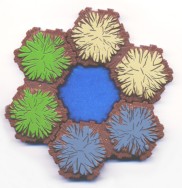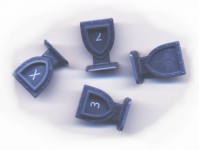|

SoulSteader
is a game variant of HeroScape
that can be played with any number of people. This game allows the
process of building the landscape to be an intrinsic part of
gameplay, and not merely a task performed prior to battle. It is
intended as a better way to play HeroScape, one which makes every
aspect of the product part of the gameplay itself.
The
Premise of SoulSteader is that the Valhalla
battles of HeroScape take place literally in a strange version of the
Norse afterworld. All the heroes of the game are considered to have
already fallen in heroic conflict, and as warriors have been granted
a place in the afterlife, in Valhalla. The afterworld of warriors is
a place of eternal battle by day, followed by endless nights of
feasting and pleasure. However, being a warrior heaven, the degree of
pleasures at night is dependant on the status of a warrior, and
status in Valhalla is dependant on the amount of spiritual territory
claimed by an individual, or an allied group of warriors.
The
Wellsprings of HeroScape are therefore considered exactly that,
Wellsprings of immortality and spiritual power. A Wellspring in
SoulSteader is a single HeroScape water tile, which must be
completely surrounded by land tiles, to form a Spirit Wellspring.
This
is the initial start position for any player. |
 |
All
Players begin by building a Spirit Wellspring.
This can most easily be done by using three 2-hex pieces to make a
ring, then placing one water tile in the middle. The completed
Wellspring allows the player to draft one hero card, and to place on
the land tiles surrounding the Wellspring, any and all figures
associated with that card. This is the beginning of their campaign to
create a personal space, a SoulStead,
within the swirling, misty, astral void of Valhalla. Once every
player has built a Wellspring, and has placed their initial hero or
heroes, the game can begin.
Page
1
|

Each
Turn a
player may perform each of the following actions:
1.
Roll Order Markers as dice and use the result to determine land,
water tile, glyph and Hero Card allowances.
2.
Place
any land or water tiles, glyphs, heroes or squads on their own
private landscape (SoulStead).
3.
Move any one already existing hero or squad across the astral void to
the nearest edge of any other players personal SoulStead.
4.
Battle normally, if possible.
ORDER
MARKERS AS DICE Perhaps the most unusual
aspect of SoulSteader is that the grey, plastic Order Markers are not
used as Order Markers in the game at all. Instead, the Order Markers
are used purely and only as dice.
Select
four Order Markers, one of each type; 1, 2, 3, and X.
These
will now be used as dice to determine how much, if any, land pieces,
glyph pieces, water tiles, are generated for a player that turn, or
if they may summon a hero or squad from out of a Wellspring.
Roll
the Order Markers as though they were funny shaped dice.
If
any marker lands number or letter face up, flat on the table, then
that number is read and used.
If
the marker lands on its side, face down, standing upright, or in any
other position than flat and face up, then nothing is gained from
that marker. |
 |
The
results of the four marker-dice are read and
interpreted thusly:
Any
numbers,
such as "1", "2", or "3" on any
face-up markers are added together, and the result is the number of
land pieces that may be taken out of the box and added to your
SoulStead landscape that turn. The size or shape of a given land tile
piece is not important, and may have any number of hexes in it. The
player may choose all small pieces, or large pieces, or any
combination thereof. But the player cannot take more individual land
pieces than they have rolled on the marker-dice.
An
"X" means
that the player may either gain
one water tile, OR
gain
one random plastic glyph, OR summon
one hero or squad (draft a hero card). Only one of these
options may be taken in a single turn. Summoned heroes or squads can
come only from a complete, fully constructed Wellspring as described
above, and such figures must be placed on open hexes immediately
beside the Wellspring water tile.
Page
2
|
|

TO
BUILD a
Wellspring, a player must first construct land pieces such that an empty
space,
one hex in size, is created. If the player has previously rolled
their marker-dice and the result is that they have chosen to take,
and put aside for later a water tile, the water tile may now
be played into the one-hex hole in the landscape, thus creating a Wellspring. |
 |
WELLSPRINGS
ARE IMPORTANT. A player may have any number of
Wellsprings on their personal SoulStead, and there are advantages to
making many Wellsprings. An open, oncovered Wellspring is the only
source from which new heroes or squads can come.
A
player is beaten, and their SoulStead is lost, whenever another
player manages to place a figure on the water tile of every
Wellspring of another players land.
Thus
the more Wellsprings, the harder a Soulstead land is to capture.
A
Wellspring is also the only way that Glyphs can be used in SoulSteader.
When
a player rolls an "X" on the Marker dice, one option is
for them to take a randomly selected plastic glyph from the box.
The
only way that a glyph can be played is for the glyph to be placed,
face up, covering an established Wellspring. This activates
the glyph, making the power of that glyph available to every unit of
the player that owns the activated glyph. The power remains in effect
until either the player who owns the glyph decides to flip it over
during a turn to 'switch it off', or the glyph is controlled by a
figure belonging to another player. A glyph is controlled by another
player when a figure belonging to them is placed onto it. The control
lasts only as long as the figure remains on top of the glyph. The
controlling enemy player now benefits as though the glyph had been
placed on their own land, and can be switched on, or off, normally.
For control of such a captured glyph to return to the owner of the
SoulStead land, the invader standing upon it must be driven off or defeated.
Once
a glyph is placed upon a Wellspring, it can never be removed, only
'switched off' or 'on' by flipping.
THEREFORE,
since only an uncovered, unblocked Wellspring can be used to
summon heroes and squads to a SoulStead, it is vital to leave at
least one Wellspring uncovered by glyphs or figures. It must also
have empty hexes around the Wellspring for new figures to appear
upon, otherwise, no new heroes can be summoned.
Page
3
|
|

ASTRAL
TRAVEL occurs
when a player wishes to venture forth from their own private
SoulStead island, floating in the astral mists, to attack the
SoulStead of another player. Astral travel is easy in Valhalla, but
follows special rules.
A
hero or squad to reach another SoulStead must move normally off the
edge of one SoulStead landscape and be placed onto the intervening
tabletop that separates the individual SoulSteads. The edge that the
figures move from must directly face the intended target SoulStead.
On the next turn, the hero or squad may move onto a directly facing
edge hex of the targeted SoulStead. The hero or squad must stop
movment once such an edge hex is reached and may move normally only
on the next turn. In effect, the Astral Void acts as a kind of water,
where, as per the general rules of HeroScape, movement must end upon
entry. However, the Astral Void is more hazardous than mere water,
and require an entire turn to leave as well. Distance within the
Astral Void does not exist, only direction. While a hero or squad
must travel to whatever SoulStead is directly opposite the point
which they exit their own lands, there are no hexes to count between
the two lands, and distance is of no consequence.
In
this example of Astral Travel, the hero figure must first move off
of the SoulStead of one player to float in the Astral Void for one
turn. On the next turn, the hero figure may be moved to any one hex
which directly faces the SoulStead he came from. Facing hexes of the
two SoulSteads are marked with red dots; these are the only hexes
that can legally be moved out from into the void, or moved into, away
from the void.
A
good way to think of it is that one may only travel to or from the
facing edge hexes of any two SoulSteads.
Battle
cannot occur within the Astral Void, but only upon a SoulStead. |
 |
Once
heroes and squads belonging to one player
achieve landfall upon another SoulStead, normal battle can occur. The
goal is to capture all of the Wellsprings of another Soulstead, by
placing a figure upon them. It does not matter if the Wellspring has
a glyph installed upon it or not. When all of the Wellsprings of a
SoulStead are captured, the SoulStead is captured, and all heroes and
glyphs upon it become the full property of the capturing player. The
losing player is out of the game. The winner of a game of
SoulSteader is the last player standing, who will naturally own everything.
HARK
sing the Valkyries of Valhalla, a new star has risen to power in the
Afterworld. For now.
Page
4
|